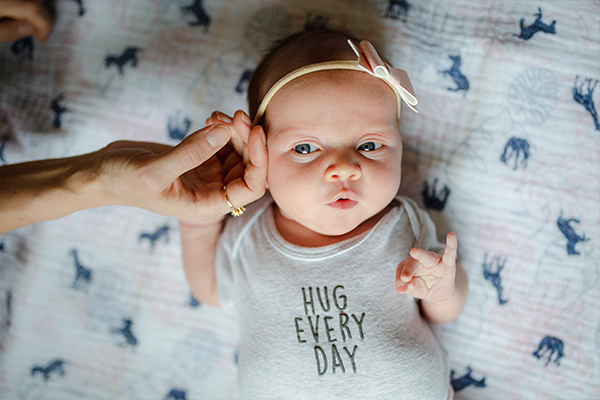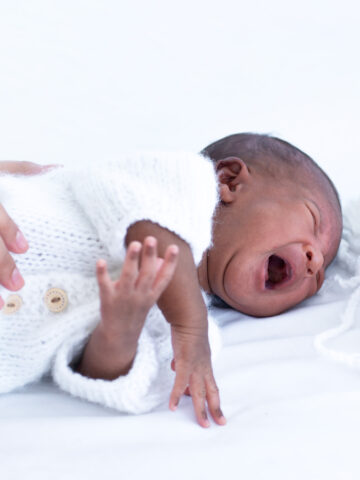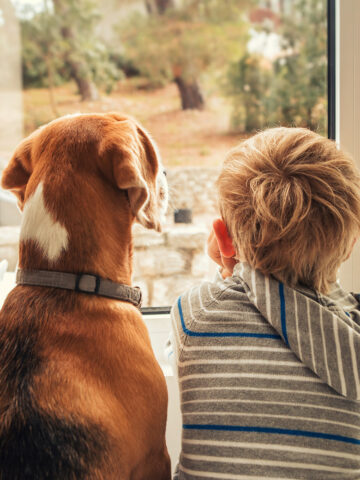Newborn Development: 0-1 month
Newborn Developmental Milestones
From the moment babies are born, they respond to the world around them. Their reactions — being calmed by a parent’s embrace or startled by a loud sound — are examples of normal infant development.
Doctors use milestones to tell if a baby is developing as expected. There is a wide range of what is considered normal, so some babies may gain skills earlier or later than others. Babies who were born prematurely may reach milestones later. Always talk with your doctor about your baby’s progress.
Newborn Development Areas
How Much Will My Newborn Grow?
In the first month of life, babies usually catch up and surpass their birthweight, then steadily continue to gain weight. A weight loss up to about 10 percent of birthweight is normal in the first two to three days after birth. However, the baby should have gained this back and be at his or her birthweight by about two weeks. While all babies may grow at a different rate, the following indicates the average for boys and girls up to 1 month of age:
- Weight: after the first two weeks, should gain about 1 ounce each day
- Average length at birth: 20 inches for boys, 19 3/4 inches for girls
- Average length at one month: 21 1/2 inches for boys, 21 inches for girls
- Head size: increases to slightly less than 1 inch more than birth measurement by the end of the first month
What Factors Determine My Newborn’s Physical Growth?
Different things can affect a baby’s size at birth. The length of the pregnancy is important. Babies born around their due date or later tend to be larger than those born earlier. Other factors include:
- Size of parents. Big and tall parents may have larger-than-average newborns; short and petite parents may have smaller-than-average newborns.
- Multiple births. With twins, triplets or other multiples, parents can assume their babies may be a bit small. Multiples have to share their growing space in the uterus, and they’re often born early, which leads to smaller size at birth.
- Birth order. First babies are sometimes smaller than brothers or sisters born later.
- Gender. Girls tend to be smaller, and boys larger, but the differences are slight at birth.
- Mom’s health during pregnancy. Babies may have a lower birth weight if the mother has high blood pressure or heart problems; or has used cigarettes, alcohol or illegal drugs during the pregnancy. If the mother has diabetes or is obese, the baby may have a higher birth weight.
- Nutrition during pregnancy. Good nutrition is vital for a baby’s growth — before and after birth. A poor diet during pregnancy can affect how much a newborn weighs and how the infant grows. Gaining a lot of weight can make a baby more likely to be born bigger than average.
- Baby’s health. Medical problems, including some birth defects and some infections during the pregnancy, can affect a newborn’s birth weight and later growth.
What can my baby do at this age?
Although a newborn spends about 16 hours a day sleeping, the time a baby is awake can be busy. Much of a newborn’s movements and activity are reflexes or involuntary – the baby does not purposefully make these movements. As the nervous system begins to mature, these reflexes give way to purposeful behaviors.
Reflexes in newborns include the following:
- Root reflex. This reflex occurs when the corner of the baby’s mouth is stroked or touched. The baby will turn his or her head and opens his or her mouth to follow and “root” in the direction of the stroking. The root reflex helps the baby find the breast or bottle.
- Suck reflex. When the roof of the baby’s mouth is touched with the breast or bottle nipple, the baby will begin to suck. This reflex does not begin until about the 32nd week of pregnancy and is not fully developed until about 36 weeks. Premature babies may have a weak or immature sucking ability, because they are born prior to the development of this reflex. Babies also have a hand-to-mouth reflex that accompanies rooting and sucking and may suck on their fingers or hands.
- Moro reflex. The Moro reflex is often called a startle reflex because it usually occurs when a baby is startled by a loud sound or movement. In response to the sound, the baby throws back his or her head, throws out his or her arms and legs, cries, then pulls his or her arms and legs back in. Sometimes, a baby’s own cries can startle him or her, initiating this reflex. The Moro reflex lasts until the baby is about 5 to 6 months old.
- Tonic neck reflex. When a baby’s head is turned to one side, the arm on that side stretches out and the opposite arm bends up at the elbow. This is often called the “fencing” position. The tonic neck reflex lasts until the baby is about 6 to 7 months old.
- Grasp reflex. With the grasp reflex, stroking the palm of a baby’s hand causes the baby to close his or her fingers in a grasp. The grasp reflex lasts only a couple of months and is stronger in premature babies.
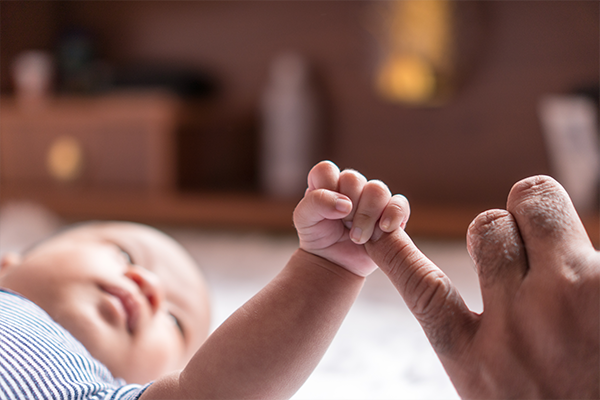
- Babinski reflex. With the Babinski reflex, when the sole of the foot is firmly stroked, the big toe bends back toward the top of the foot and the other toes fan out. This is a normal reflex until the child is about 2 years old.
- Step reflex. This reflex is also called the walking or dance reflex because a baby appears to take steps or dance when held upright with his or her feet touching a solid surface.
Newborn babies not only have unique reflexes, but also have a number of physical characteristics and behaviors that include the following:
- Their head sags when lifted up and must be supported at all times
- They turn their head from side to side when lying on their stomach
- Their eyes are sometimes uncoordinated and may look cross-eyed
- They initially fix their eyes on a face or light, then begin to follow a moving object
- They begin to lift their head when lying on their stomach
- Their movements are jerky and erratic
- They move their hands to their mouth
What can my baby say?
At this early age, crying is a baby’s only form of communication. At first, all of a baby’s cries sound similar, but parents soon recognize different types of cries for hunger, discomfort, frustration, fatigue and even loneliness. Sometimes, a baby’s cries can easily be answered with a feeding or a diaper change. Other times, the cause of the crying can be a mystery, and the crying stops as quickly as it begins. Regardless of the cause, responding to your baby’s cries with a comforting touch and words are essential in helping your baby learn to trust you and rely on you for love and security. You may also use warmth and rocking movements to comfort your baby.
What does my baby understand?
You may find that your baby responds in many ways, including the following:
- Startlingat loud noises
- Lookingat faces and pictures with contrasting black and white images
- Givingattention to voices, eventually turning toward sounds
- Showing hints of a smile, especially during sleep
How Long Should My Newborn Sleep?
Newborns should get 14-17 hours of sleep over a 24-hour period, says the National Sleep Foundation. Some newborns may sleep up to 18-19 hours a day. Though newborns spend most of a 24-hour period sleeping, it is best that they do not sleep for longer than 5 hours at a time in the first 5-6 weeks because they need to wake every couple hours to eat. Breastfed babies feed often, about every 2-3 hours. Bottle-fed babies tend to feed less often, about every 3-4 hours.
Expect to wake your newborn every 2-3 hours to eat until they surpass their birth weight, which usually happens within the first couple of weeks. After that, it’s okay to let your baby sleep for longer periods of time at night if they are gaining weight appropriately (about 1 pound per 2 weeks).
The first months of a baby’s life can be the hardest for parents, who might get up many times at night to tend to their baby. Each baby has a different sleep pattern. Some start to sleep “through the night” (for 5-6 hours at a time) by 2-3 months of age, but some don’t.
See healthy sleep for babies for more information about newborn sleep.
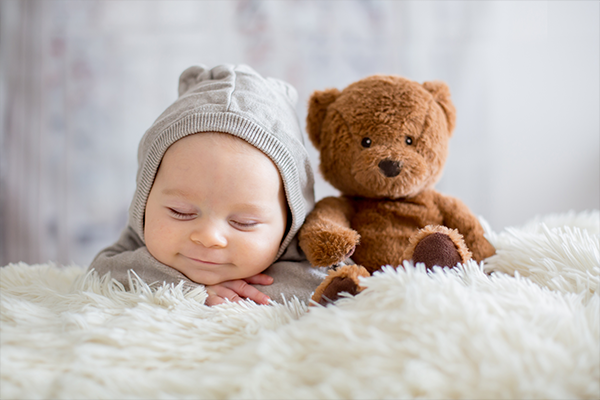
How can I help increase my baby’s development and emotional security?
Young babies need the security of a parent’s arms, and they understand the reassurance and comfort of your voice, tone and emotions. Consider the following as ways to foster the emotional security of your newborn:
- Hold your baby face to face.
- Talk in a soothing tone and let your baby hear your affectionate and friendly voice.
- Sing to your baby.
- Walk with your baby in a sling,carrier or a stroller.
- Swaddle your baby to helpthem feel secure and prevent startling by the baby’s own movements.
- Rock your baby in a rhythmic, gentle motion.
- Respond quickly to your baby’s cries.
Reviewed by Dr. Mary Choi, Seaview Pediatrics, CHOC Primary Care – June 2021
Your child’s health is important at every stage. Visit CHOC Primary Care for pediatric services near you.
What's coming up for your child
Articles
A CHOC pediatrician explains the causes of colic in babies, and offers tips to parents for helping their colicky baby.
When siblings Julissa and Joseph were diagnosed with the same rare congenital heart disease, CHOC stepped in to treat them both.
Should teens and preteens be using so many skincare products with fancy ingredients? A pediatric dermatologist answers parents’ questions.
11-year-old Isa had to relearn everything after treatment for FIRES, a rare epilepsy disorder. With help from CHOC rehab, he’s thriving.
A CHOC mental health expert demonstrates five coping tips for parents and caregivers through video, and discusses the importance of self-care.
A CHOC mental health expert helps parents guide their kids and teens through the loss of a family pet, and offers tips for dealing with grief.
